
24 minute read
Column Bridge Heights Are Not Guesswork
Bridge Heights Are Not Guesswork Accuracy Is Imperative
“Your true pilot cares nothing about anything on earth but the river, and the pride in his occupation surpasses the pride of kings.” -Mark Twain, Life on the Mississippi (1883).
Advertisement
That statement made by the great chronicler and river pilot over 137 years ago is arguably as true today as it was then. But what has changed dramatically in the almost century and a half since then is the variety and complexity of the daily challenges that river pilots confront on our increasingly busy inland waterways. The sophistication of locks, dams and bridges, the unpredictable fl uctuations in water levels and the consequences to those who fail to factor in all of the above when planning their commercial river trips can be costly career killers.
Even in Twain’s day, one key concern of any experienced river pilot was the depth, width and height of not only his vessel, but, as importantly, whatever that vessel was pushing or pulling. While those measurements were a constant for his vessel, the variances of the sizes of that day’s job were unpredictable. And, while water levels change and navigable channels widen and narrow, bridge heights don’t. It’s up to the pilot to make adjustments to his calculations and safety margins according to that day’s river conditions. If that isn’t done, the potential consequence of a bridge allision could be the beginning of a very long and diffi cult battle to defend his pilot’s license, career on the river and professional reputation.
The case highlighted here is not at all unusual in the set of facts and, sadly, in its outcome as well.
A lapse in judgement
In late fall, our pilot was serving onboard a towboat on a Midwest river and towing astern a 50- by 50-foot fl exifl oat spud barge. On board the barge was a deckhand and two observers. The workboat pilot had towed several fl exifl oat barges previously, but it was his fi rst time towing this specifi c fl exifl oat spud barge. The trouble truly began when he eye-balled the spud height above the water level to be 35 feet. Unfortunately, he did not directly measure the spud height, inquire about the exact height or go onboard the barge to check the height himself. What made matters worse, was the fact that these particular spuds could be positioned either all the way up or all the way down. Ominously, the spuds were in the full up position.
The captain commenced what was planned to be a fourmile transit route requiring passage under a vertical lift railroad bridge. The bridge, which had a vertical clearance of 35 feet when down and 135 feet when raised, was manned 24/7 and the operator could raise it partially or completely depending on the circumstances and communications received from approaching vessels via marine radio.
Seeing that the bridge was in the down position as he approached, the pilot judged that “he could make it under the bridge without problems.” It was daylight, weather conditions were favorable with an ebb current and 4 nautical miles visibility.
The towboat passed under the railroad bridge, but as the fl exifl oat spud barge being towed astern was proceeding underneath the bridge, the spuds on the barge came in contact with the lower railroad steel beam of the bridge, resulting in damages to the spuds and, possibly, the bridge.
Following the allision and as the shaken pilot was assessing damage to the barge and attending to other potential onboard safety issues like fl ooding and pollution, the railroad bridge operator immediately reported the incident to the local Coast Guard station prompting the on-duty USCG safety offi cer to contact the pilot for confi rmation that his tow had indeed struck the bridge. The pilot confi rmed the allision with the bridge and reported that the lower two bolts of the forward spud well bent over and the aft spud well’s upper bolts broke, causing the aft spud and well to bend backwards. He further reported no damage to his vessel or, to the best of his knowledge the railroad bridge.
An open & shut case
After his conversation with the Coast Guard offi cer, the pilot reported the incident to his license insurer and was
immediately assigned a local maritime attorney who assisted him in the completion and submission of the Marine Casualty Report (2692) and subsequently accompanied the river pilot to his in-person Coast Guard interview.
The meeting was brief. The pilot was charged with negligence for both failing to check and verifying the height/draft of the barge’s spuds, and failing to request the operator to raise the bridge to facilitate safe passage. He was offered a settlement agreement of an outright three-month license suspension with an additional ninemonth probationary period following the completion of his ‘beach’ time.
After debating the merits of contesting the terms of the settlement offer, both he and his attorney agreed that, given the absence of mitigating circumstances, the most
Inland Waterways
By Randy O’Neill
prudent, yet painful, decision was to accept the suspension with probation offer.
Because he had opted for income protection when purchasing his license insurance policy, the pilot received his insured wages for the duration of his suspension, but no amount of money could compensate the hit to his professional reputation caused by two egregious lapses in judgement: not verifying the spud’s height and/or not requesting the bridge to be raised.
Because this column opened with an upbeat quote from Mark Twain, it’s only fi tting that we end it by going back a few millennia to ancient Greece and the sobering, yet cautionary, words of the tragedian Sophocles who wrote, “Men of ill judgement oft ignore the good that lies within their hands, till they have lost it.”
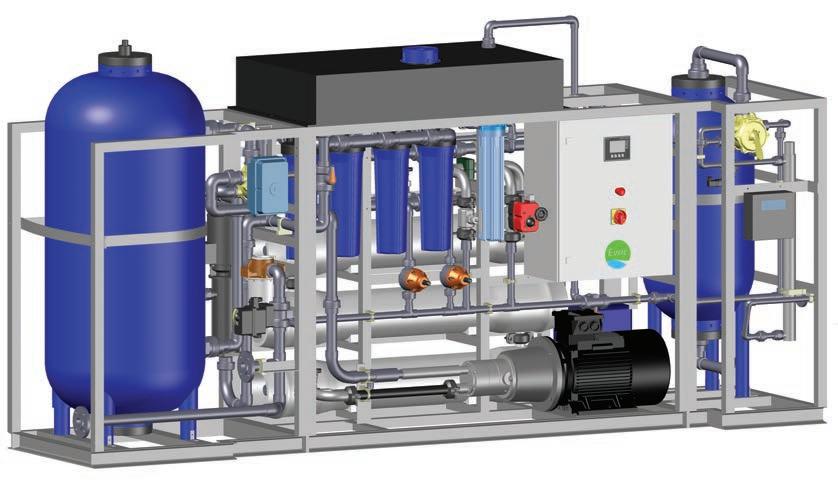
Reverse Osmosis and the New Dawn of Marine Desalination

By Jim Romeo
Today’s desalination plants are rugged, durable and highly automated to meet the demands of operators and the crew, enabling them to meet schedule and mission with ample potable water production.
In the days of old, marine distilling plants – then mostly steam – relied on archaic fl ash evaporators, which used steam to heat, power an air ejector, and ultimately create a vacuum whereby seawater would fl ash or boil and ultimately be distilled. The process would often occur over two stages and what did not fl ash would be pumped overboard as brine. Times have changed. So has the associated equipment with more effi cient equipment that’s easier to operate and maintain.
Marine evaporator plants which had used steam, built up scale easily. They were subject to steam fl ow, temperatures and pressures which lead to high maintenance. They incorporated several pumps, alarms, dump valves, sight glass indicators and were prone to many reliability and performance challenges. Plus, they were labor intensive, often requiring a watch stander to dedicate much time to their operation, being careful to fi ll appropriate tanks, have careful vale alignment, and ensure that all heat exchangers within the system were working.
They also required extensive periodic maintenance and were somewhat cumbersome. This has all changed with the emergence of reverse osmosis and desalination vessels on modern marine and offshore vessels. The new technology is a critical link in a vessel’s ability to operate and provide a self-suffi cient source of fresh and potable water for the crew and any other applications that might require fresh water.
The new dawn of reverse osmosis
Jeffrey Lum, is a sales and account manager for EVAC, a leading provider of integrated water and waste management systems for the marine, offshore and building industries in South Florida.
“The evaporator was the most common way of securing water during transit,” says Jeff Lum. “But with the new trend of slow-steaming, and the reduction of power for diesel-electric vessels, it [the ship] becomes more of a consumer than a benefi t.” With the evolution of reverse osmosis units being implemented, shipboard, the equipment’s

All photos: FCI Watermakers

economy and overall effi ciency was improved.
“The energy required to start the evaporator is costly,” adds Lum. “The reverse osmosis plants were created as a better and more effi cient alternative and have been pretty standard since the mid ’90s.”
In actuality, potable water produced by reverse osmosis (RO) is a consummate form of water treatment. It is fi ltered by membranes, down to the micron level, and provides the purest of water.
“The osmosis process is liquid diffusion through a membrane,” says Lum. “ If we have two buckets, one with fresh water and the other with saltwater and connect both with a membrane, the natural process would be that the fresh will migrate the salt side. The reverse process is that we insert pressure in the saltwater side, forcing it to the fresh side while the salt residues remain in the membrane. The permeate water after the process is so pure that it needs to be processed with minerals so it can be consumed. The end quality product is much better than what we drink from our residential faucets.”
Lum says that in the new build segment, where the specs have been rewritten to be more effi cient. “The RO plants are installed since this period,” he says. “But in the refi t [or retrofi t] segment [of the marine market], there is a common trend to either install more units, revamp older plants and replace evaporators with RO’s.”
Scott McGuire is president of FCI Watermakers based in West Valley, Utah. FCI Watermakers is a leading manufacturer of desalination plants for the marine and offshore industry. He says today’s desalination RO plants are highly automated, with the operator in mind.
Automation for operation
“We’ve moved away from anything that really has any type of manual interface,” explains McGuire. “It’s all automated now. It’s one touch operation. All the pressures come up automatically. All your settings will adjust automatically, based upon the water you’re running in. We’ve eliminated the end user, or the indicator, from the process so that they no longer have to worry about turning the machine on the pressure and then coming back and monitoring it all the time.”
McGuire points out that the automation was driven by the change in operators. Shipboard engineers go from ship to ship and often don’t have time to learn a new system or get deeply involved with the systems. “Our attempt at automation was to make it as simple for the user, no matter who that user is and what their skill set was, to operate these machines,” he says. “We’ve even eliminated belts and pulleys and anything that has to do with it.” He acknowledges that older units have more mechanical parts and it becomes a maintenance item, as belt and pulley drives may get out of adjustment. “It’s all direct drive now,” he says. “With gearbox, reduction gears, or even direct coupled- depending upon the size of the system, to them by controlling the speeds of the motors.”
Durable and reliable high-pressure pumps
For RO units and desalination plants on one skid, very durable, and rugged high-pressure pumps are required. McGuire says he’s seen the gamut of high-pressure pump manufacturers and features. There once were bronze and brass pumps used. Then nickel aluminum bronze pumps came along - without great results. Then there were radial axle pumps that did not require oil. But, as McGuire explains, the best highpressure pumps he found were those made from 316 stainless steel as it had the best performance and the greatest durability and has been FCI Watermakers’ choice in highpressure pumps. 316 stainless steel is ideally suited for marine and saltwater applications and is the required material for the service these pumps endure, and the critical function they perform, in a very important shipboard system.
Aftermarket support
A common issue with desalination plants is parts replacement, or more specifi cally, membrane replacement. The RO membrane does not last forever. Periodically it needs to be replaced. Acquiring a replacement membrane becomes problematic because not all membranes are suitable for a particular unit. Very often, a ship may order a membrane in a foreign port or a remote location, and it is an unsuitable membrane that becomes a bad performing membrane.
As McGuire explains, often a Chief Engineer or ship owners needs to replace a membrane and connects with their local ship chandlery, or their local vendor. They replace it with an off-spec membrane, put it in, and it’s not designed for the normal operating pressure, gallons of output, or that desalination plant design.
“And so, they don’t perform correctly,” says McGuire. “Stick with the membranes that are specifi ed on the machine, because they’re designed for that machine.
“We can resupply from any number of distributors we have around the world or they can call us directly,” explains McGuire. “We stock hundreds of membranes. And we’ll always have stock of membranes. We can get them to you wherever you are”
But he cautions about having stagnant membranes in inventory. “Because membranes usually have a shelf life of a year, some dealers don’t like to put them on a shelf because it just sits there and then it might go bad on them. So, often they will just deploy directly from us.”
Proper operation and maintenance
Another point of design for FCI Watermaker operation is the inclusion of automatic freshwater washes periodically. “Every time that machine turns off, the system fl ushed itself with fresh water,” he says. “So, the membranes, the fi lters, the high-pressure pumps, all that are sitting in salt water for the long duration.” He says they have allowed
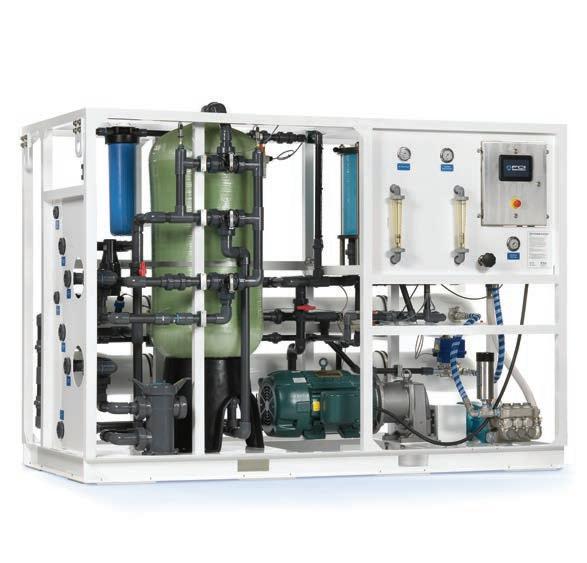

their automation to be programmed to automatically fl ush the system with fresh water, if it goes into lay up for a period of time or will be idle for a prolonged period of time.
McGuire says that with timely, scheduled maintenance, and prompt replacement of consumable parts on the plant such as seals, wearing rings, membranes, and any other necessary parts, the system can las the life of the ship. “You could feasibly build a ship tomorrow and with proper maintenance, proper backfl ow, proper fl ushing, and periodic replacement of certain parts, it should last.
“We have systems that are still running from the fi rst systems that we ever put out there,” he says, “It’s a matter of replacing the consumables, keeping up on the maintenance of the system. So, you can keep this thing going for as long as you want to keep replacing parts.”
Keeping desalination plants is a critical link in shipboard operation. The availability of fresh water for the crew is a determinant factor in the vessel maintaining its mission and staying on schedule. This becomes very important if a vessel is unable to take on potable water along its voyage or must operate for long stretches of time. Desalination plants, operating properly, with the right maintenance and equipment, are crucial to smooth and effi cient marine engineering.
“Water is becoming somewhat of a commodity,” says Lum. “In the cruise segment, we see that the passengers are utilizing more freshwater every year, but there is a lot of waste as well. Black and grey water process should be one of the topics shortly as a lot could be re-utilized as technical water.”


The second of three vessels for New York City’s Staten Island Ferry was launched by Eastern Shipbuilding this summer.
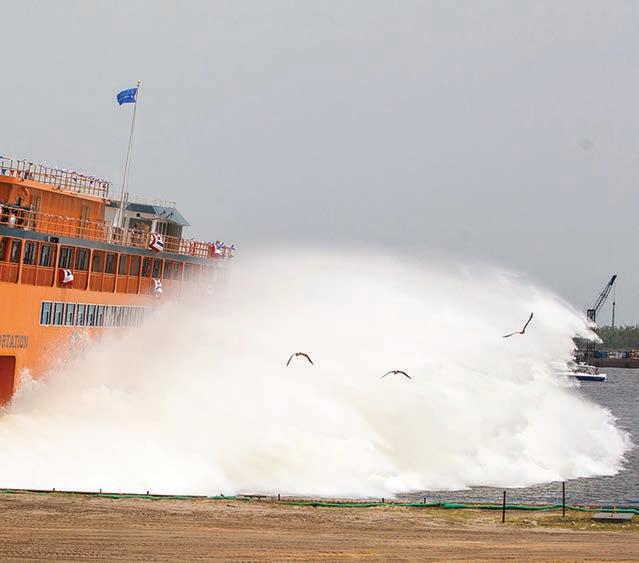
The American shipbuilding scene, fi lled with participants constructing all manner of vessels, has been navigating through stormy times (lately, yards along the Gulf Coast have literally been dealing with storms). The orders for newbuild, repair and conversion projects continue to fl ow in—albeit at a reduced pace—and the boats and ships go down the ways into the water, but the overall panorama has seen tremendous sea changes as the business has shifted.
Maritime businesses worldwide have been grappling with currents both internal and external. Across the entire landscape in 2020, the COVID-19 pandemic has brought about operational changes that will continue into the future, long after Americans are vaccinated. Most U.S. shipyards were identifi ed early on as “essential businesses”, and therefore continued working throughout 2020. The proactive attitude of one yard during 2020’s pandemic did not go unnoticed, with Fincantieri Bay Shipbuilding (FBS) receiving the Northeast Wisconsin Service Award. As explained in a press release from FBS, “The award honors the unsung heroes of the coronavirus who helped keep Wisconsin moving while the state was shut down. Honorees are selected for going above and beyond the call of duty in their respective fi elds or industries.”
Throughout the maritime world, again refl ecting broader trends, talk has turned to “decarbonization” (with reduced CO2 going beyond notions of simply improving vessel effi ciency), which will have profound implications for vessel propulsion and fuel choices. Initially, this trend has driven a movement toward liquefi ed natural gas (LNG) fueled propulsion. In Pascagoula, Miss., the Halter Marine yard will soon be completing the tug barge combination Q-Ocean Service / Q-LNG 4000, for Q-LNG. The 4,000 cubic meter unit will be contracted to Shell, and will be handling both ship-to-ship and ship-to-shore transfers of LNG to vessels and to shoreside LNG distribution depots.
Indicative of the currents, FBS, in Sturgeon Bay, Wis., held a modern day “keel laying ceremony” (with pre-constructed modules laid in place), in late June, for an LNG bunker barge, Clean Canaveral, that will provide fuel to shipping customers of NorthStar Midstream (tied to private investor Oaktree Capital), along the U.S. East Coast, out of Jacksonville. The 5,400 cubic meter articulated tug barge (ATB) unit will be owned by a new entity, Polaris New Energy, which has options on two additional units.
With its Great Lakes location, FBS is also building a 28,000 dwt. self unloading bulk carrier for Interlake Steamship, and delivered the dry bulk barge Michigan Trader to Van Enkevort Tug and Barge in August.
Along the Gulf Coast, Eastern Shipbuilding- Panama City, Fla. has also been active in multiple segments. The yard is in the midst of a three-vessel order for New York City’s Staten Island Ferry. The fi rst of the 4,500-passenger trio, Sgt Michael Ollis, is set to be delivered in late 2020 (after being delayed due to Hurricane Michael in 2018), with a second vessel, Sandy Ground, launched in June 2020. The yard has continued to work, in the midst of the pandemic and an active hurricane season. In August, Eastern, which had previously been a prodigious producer of tugboats, delivered the 5,100 hp Z-drive ship-handling tug A. Thomas Higgins to E.N. Bisso (following up on a sister vessel C.D. White delivered earlier in the year).
Also in the Gulf, the Metal Shark facilities, encompassing three locations in Louisiana and Alabama, have been active, with a varied construction slate. The Bayou La Batre, Ala. facility (previously the Horizon Shipyard) recently delivered a 6,000 hp boat to Florida Marine Transporters (FMT), the fi rst of a three boat order, and the yard’s fi rst towboat for the inland marketplace. The Metal Shark yards have also continued to deliver ferries to NYC Ferry (in New York) and to Potomac Water Taxi, in the Washington, D.C. area. Metal Shark, also a prolifi c builder of fast boats for law enforcement and for military users, credits “series production” to its ability to deliver vessels rapidly and at scale, at a time that cities such as New York seek to
move commuters from automobiles onto ferries.
A different sort of environmental theme (against a backdrop of increased funding for dredging) is evidenced most recently with Eastern Shipbuilding beginning construction on a second new 8,550-cubic-yard trailing suction hopper dredge for Weeks Marine Inc. (with a previous unit delivered in 2017). Elsewhere, Conrad Shipyard is building a 6,500-cubic-yard TSHD for Great Lakes Dredge & Dock Corporation. And the Keppel AmFELS yard at Brownsville, Texas announced an order for a 15,000-cubic-yard hopper dredge, to be delivered in 2023 to Manson Construction. The yard (historically a builder of jack-up rigs) is also constructing two LNG-fueled containerships that will be deployed by Pasha Hawaii in the Jones Act trades from the West Coast.
On the West Coast, General Dynamics’ NASSCO, in San Diego (which, like the Philly Shipyard on the East Coast, had earlier successes in delivering multi-vessel series of Jones Act suitable double hulled tankers as the pre-OPA fl eet was being phased out), delivered Lurline, the fi rst of two 3,500 TEU container vessels to Matson, which also boast a 500 vehicle garage capacity. A second vessel, Matsonia, is expected to be delivered in late 2020. The vessels, readily upgradable for LNG fueling in the future, will serve in the line’s West Coast- Hawaii trades.
With oil price wars and trade wars, economists can ar-
The new maritime academy training ships will be built at Philly Shipyard.

gue about whether we are in a “slowdown” or a “recession”. However, weak demand on the commercial side (energy and also agricultural) has seen a counterbalance from the government side. The Philly Shipyard has chosen to pivot from commercial to government work- with the contract award emphasizing a need to infuse commercial best-practices. The Philly Shipyard, which had completed a pair of container vessels for Matson, is now set to begin construction, initially, of two training ships destined for maritime academies (with the fi rst going to Fort Schuyler- State University of New York). The newbuilds, with Tote Inc managing the actual contracting and construction process for the U.S. Maritime Administration, will go way beyond

Matt Tremblay, ABS




their role in training maritime cadets. As National Security Multi-Mission Vessels, their capabilities will enable them to respond to natural disasters, and provide humanitarian aid. The vessels, set to join the National Defense Reserve Fleet, will have ro-ro capabilities (for heavy equipment) and extensive berthing capacity. NASSCO, with no additional deepsea commercial orders announced, is putting its tanker expertise to work, building a series of fl eet oilers for the U.S. Navy. Halter Marine is also constructing vessels for the Coast Guard and the Navy, and Eastern is building the Coast Guard’s fi rst offshore patrol cutters.
Bollinger’s Lockport, La. yard scored a big win in late September with a U.S. Coast Guard awarding a newbuild contract, with four fast response cutters to be delivered during 2022 and 2023. The group also recently received an order for a fl oating drydock that will service U.S. Navy submarines at General Dynamics Electric Boat yard at Groton, Conn. Austal, another yard with commercial work in its past at its Mobile, Ala. yard (the old Bender facility), has delivered a fast transport ship to the U.S. Navy, with multiple transports also under construction. Like other yards, it has benefi ted from government work, in this case, with a specialty in troop transports and landing vessels.
The sustainability trend looms large. In the not too distant future, additional U.S. built vessels will be needed to serve offshore wind energy projects. The rumor mill is whirring about numerous discussions said to be underway between project developers and U.S. owners regarding installation vessels. Matt Tremblay, ABS Senior Vice President, Global Offshore, told Marine News, “ABS is involved in a range of projects to support the development of the U.S. offshore wind industry, including providing services to vessels destined to be constructed in U.S. shipyards.” He added, “As the industry and the turbines continue to grow in size and complexity, the vessels needed to install them in U.S. waters will need to be built, and we are seeing increased demand for increasingly specialized vessels. ABS is involved in advanced discussions with key players on the development of further Jones Act vessels which will be key to the development of the U.S. industry.”
Choosing a Yard: One Customer’s Perspective

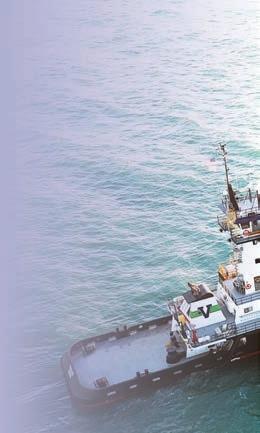
Vane Brothers, a leading participant in coastal and harbor movements of petroleum products and ship bunkering, has been a major customer of U.S. yards. Capt. Jim Demske, who is in charge of newbuild construction at the Baltimore based vessel owner, explained his criteria for sizing up a potential builder of new equipment for Vane. He explained, “Among many considerations, I want to know the yard’s reputation for constructing the type of tug required by Vane Brothers. I need to be certain they can build the design to our specifi cations, deliver it in a timely manner, and bring it in at our budgeted cost.” Recent Vane newbuilds have included three Assateague class ATBs (built at Conrad Shipyards with 4,400 bhp tugs coupled to 80,000 bbl barges) and two Salisbury class push boats (3,000 bhp), suitable for the inland rivers. Two more of the push boats are under construction, at Chesapeake Shipbuilding (which has also carved out a niche in building small river cruise vessels for American Cruise Lines). Capt. Demsky continued, “If the yard has been building tugs for many years, there is a good chance I have been aboard some of their tugs or designs. I would already have a good idea of what I like about their builds, their strengths and weaknesses, and what the yard can provide to ensure that new Vane vessels maximize safety, performance and crew comfort.” Vane Brothers takes a hands-on approach, with Capt. Demsky telling Marine News, “I like to walk the yard and talk with management and supervisors to get a feel for the knowledge and expertise they offer. The rapport we are able to build is always important, since I will be interacting with yard personnel on a nearly daily basis for the length of the project. During the walk, I also look to see whether the yard is well kept and effi ciently laid out. If the yard is clean and organized, I feel better about entrusting them with a Vane Brothers project.”
Tremblay explained further, “At the end of 2019 ABS granted VARD the fi rst Approval in Principle (AIP) for a Jones Act service operations vessel (SOV), with primary functions including accommodation, transferring technicians to installations as well as storing spare parts and tools for operations in U.S. offshore wind farms. That milestone has been followed by further AIPs both to VARD for a large SOV and to BAR and Chartwell Marine for an innovative Jones Act crew transfer vessel.”
Tremblay pointed to the class society’s prominent role in wind energy’s buildout, evolving analogously to offshore oil drilling towards fl oating units. “ABS provides leading classifi cation services for wind support vessels, including self-elevating units, wind turbine installations vessels and offshore support vessels. ABS classed the largest wind farm installation jack-up Seajacks Scylla in 2015 and earlier this year, to the fi rst fl oating heavy lift installation vessel to be built in Taiwan, Green Jade. ABS is also a world leader in classing fl oating offshore wind, in process of classing nearly 80 megawatts of fl oating wind.”

Capt. Jim Demske
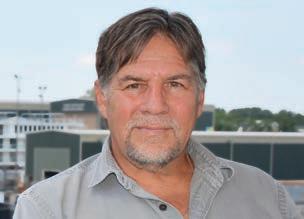
Vane Brothers


ATB built for Vane Brothers at Conrad Shipyard

Hank Carter / Vane Brothers











